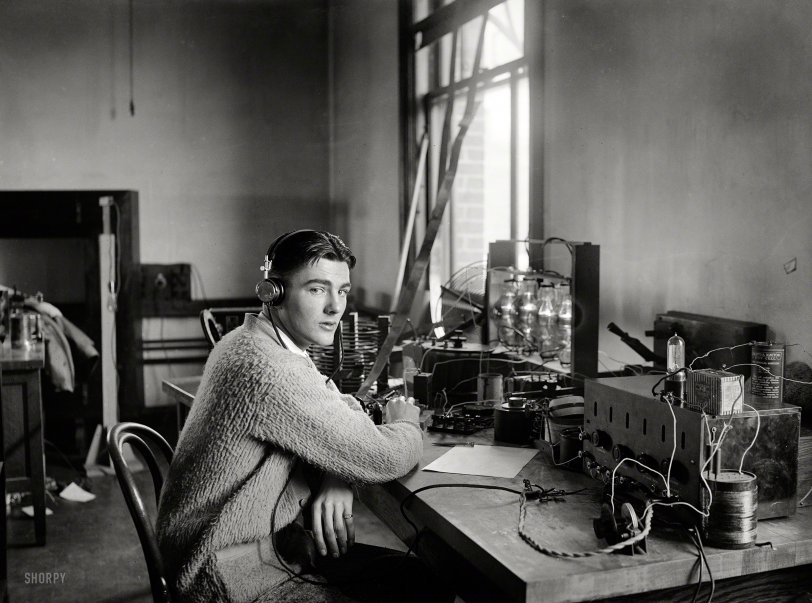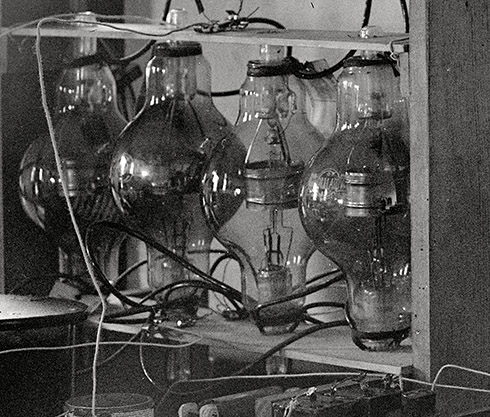


Framed or unframed, desk size to sofa size, printed by us in Arizona and Alabama since 2007. Explore now.
Shorpy is funded by you. Patreon contributors get an ad-free experience.
Learn more.

- Baldwin 62303
- Baldwin VO-1000
- Cold
- No expense spared
- Tough Guys
- Lost in Toyland
- And without gloves
- If I were a blindfolded time traveler
- Smoke Consumer Also Cooks
- Oh that stove!
- Possibly still there?
- What?!?
- $100 Reward
- Freeze Frame
- Texas Flyer wanted
- Just a Year Too Soon
- WWII -- Replacing men with women at the railroad crossing.
- Yes, Icing
- You kids drive me nuts!
- NOT An Easy Job
- I wonder
- Just add window boxes
- Icing Platform?
- Indiana Harbor Belt abides
- Freezing haze
- Corrections (for those who care)
- C&NW at Nelson
- Fallen Flags
- A dangerous job made worse
- Water Stop
Print Emporium
Warming Up: 1923

UPDATE: For a better view of the equipment click here.
Washington, D.C., circa 1923. "Herbert Hoover Jr. and radio set." Son of the future president and a noted ham. Harris & Ewing glass negative. View full size.
Flat antenna wire
"Was the antenna wide and flat to reduce inductance?"
I have a slightly later and much smaller version of that antenna wire. I always assumed that the antenna was flat so you could close the window on cold days.
Transatlantic Radio Station
New York Times, December 22, 1922.Radio of Herbert Hoover Jr. Is Heard in Switzerland
The amateur radio station of Herbert Hoover Jr. at Washington, D.C., was heard by amateurs in Switzerland on Tuesday, it was announced at the American Radio Relay League headquarters today.
When he was notified today in New York he wired the American Radio Relay League as follows: “Hooray! Have operated from 15th to 21st. Writing details now.”
He is one of about 11,000 amateurs participating in transatlantic tests with British and French amateurs.
By a coincidence, Hiram Percy Maxim, President of the A.A.R.L. was in Washington to confer with Herbert Hoover Sr. on amateur radio matters.
A Series of Tubes
We've posted a clearer view of the equipment here.

Flat feedline
Is that feedline descending from the window towards his left elbow (out of view)? Those were the days, when the antenna and the feedline were the same thing. I used a longwire that came directly into the shack, and running 300 watts made a lot of metal things hot with radio energy. I wonder if he suffered the same thing? Was the antenna wide and flat to reduce inductance?
Ready-made receiver, home-brew transmitter
I'm pretty sure that's his receiver on the far right. I'm not quite sure what the extra circuit with the batteries, tube, coil, and variable capacitor does; it might be an add-on beat frequency oscillator, which turns the "hiss, quiet, hiss, quiet" you'd get without one to the "quiet, beep, quiet, beep" that many people think of as Morse code. Or it could be totally unrelated.
The four biiig tubes in a rack to the left of that are probably the transmitter. It looks to be more of a home-brewed affair, comprising several of the other components on the table.
His right hand is on the key, I think. Just to the right of that is a knife switch; that may be his transmit/receive switch (it picks whether the antenna is connected to the transmitter or receiver). The straps going out the window might be metal foil (copper?) heading to the antenna.
Doing ham radio in the USA in 1923 would be a little bit like getting on the Internet in the USA in the early to mid 1990s. In both cases, the federal government had recently decided that the medium would be owned by corporations instead of humans, but the corporations hadn't quite figured out how to dominate it yet, so humans still had a chance. In both cases, this changed rapidly.
My father's Ham license in 1919
He would tell me about winding his own tuning coils on old empty round Quaker Oats boxes.
I think I see some similar examples in the photo of Mr. Hoover's Ham Shack
Hoover Junior
Hoover was an amateur radio operator holding the call W6ZH.
His day jobs:
Geophysical engineer and adviser to foreign governments from 1930 to 1953.
Special Envoy to Iran during 1953 and 1954
Under Secretary of State from 1954 to 1957.
























On Shorpy:
Today’s Top 5